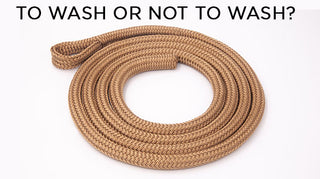Good question.
It depends.
If your rope isn't visibly dirty, it probably doesn't matter.
If your rope has gotten drug through the dirt or mud, then that dirt will decrease the abrasion resistance of the rope and lead eventually to fuzziness and if you tie your horse could even lead to failure.
Most importantly, when you do wash your rope, keep some best practices in mind.
- Don't clean your ropes with anything that "brightens colors" or has any bleach content. Warm water and a very gentle detergent is best.
- It is best to soak the rope for 5 minutes or so in a warm detergent bath to loosen the maximum amount of grime.
- It is not recommended to put your rope in the washing machine - this is a bucket job.
- Most importantly, DO NOT use the rope while it is drying. Physical stress to the rope whilst it is drying could damage its long term strength.
- Do NOT mechanically dry the rope with any sort of heat - dryer, radiator, hair dryer, etc. These are all a no-no.
Sometimes people will comment that "old ropes" feel different than new ropes. What they mean usually is fatter or fully bodied feeling. The reason for this is dirt making its way through the cover of the rope, sort of like a mattress amassing skin cells and dirt over the years (ewww, gross I know). That full bodied feeling is just dirt - it is not the rope construction being different "in the good old days" unless the maker has changed the rope construction. What you do want to be on the look out for is fuzziness of the rope's outer core with older ropes, as this could mean the rope will fail in time.
At HEC, all of our ropes have used the same construction, material and spinning specifications for things like breaking strength, diameter and stretch since we started making products in 2013. We have this year (2024) introduced a few ropes with a thicker diameter, like our new 12' Training & Games Rope for those who want that fatter feel to a rope without the aging process.
Yachting braid nylon rope in horse lead ropes, lungeing ropes and riding reins is very durable if cared for properly - which is pretty easy to do as it is sturdy and low maintenance. It is good practice to also survey the stitching regularly to make sure rot or mildew has not had an effect from storage in your tack room.
If you happen to accidentally snag a yachting braid rope, you can repair it before a snag turns into a run by using a lighter to singe the snag and stop it in its track. Smooth it over with some flat metal surface - a butter knife or the back of a spoon works just fine.

